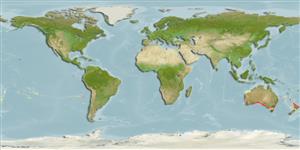Environment: milieu / climate zone / depth range / distribution range
Ecologia
marinhas associadas(os) a recifes; intervalo de profundidade 0 - 400 m (Ref. 58302), usually 15 - 60 m (Ref. 30464). Subtropical; 19°S - 42°S, 114°E - 76°W
Eastern and western South Pacific: Exact distribution unknown because of taxonomic uncertainties.
Tamanho / Peso / Idade
Maturity: Lm ? range ? - ? cm
Max length : 55.0 cm FL macho/indeterminado; (Ref. 89444); common length : 30.0 cm TL macho/indeterminado; (Ref. 30464)
Espinhos dorsais (total) : 10; Raios dorsais moles (total) : 19 - 21; Espinhos anais: 3; Raios anais moles: 7 - 9; Vértebras: 26. Lateral line scales of individuals in the eastern Pacific is 58-65, in western Pacific 61-71 (Ref. 120532). Monochromatic orange-red or with black spots on the dorsal fin (Ref. 43805). Congruent rays of the dorsal fin and a caudal fin with a deep median notch in both sexes (Ref. 43805). Preopercle serrate, but without antrorse spines (Ref. 40817).
Occurs inshore near reefs (Ref. 7300). Benthopelagic and benthic (Ref. 58302). Feeds on plankton and small nekton. Occasionally caught on small hooks when fishing in midwater without sinker and make excellent eating (Ref. 30464). Its abundant gillrakers and stomach contents characterize it as an opportunistic pelagic polyphagic-zooplanktivorous predator (Rojas et al. 1998a, c) (Ref. 89357).
Life cycle and mating behavior
Maturidade | Reprodução | Desova | Ovos | Fecundidade | Larvas
Paxton, J.R., D.F. Hoese, G.R. Allen and J.E. Hanley, 1989. Pisces. Petromyzontidae to Carangidae. Zoological Catalogue of Australia, Vol. 7. Australian Government Publishing Service, Canberra, 665 p. (Ref. 7300)
Categoria na Lista Vermelha da IUCN (Ref. 130435: Version 2024-1)
Ameaça para o homem
Harmless
Utilização humana
Pescarias: espécies comerciais
Ferramentas
Relatórios especiais
Descarregue XML
Fontes da internet
Estimates based on models
Preferred temperature (Ref.
123201): 16 - 23.2, mean 17.9 °C (based on 250 cells).
Phylogenetic diversity index (Ref.
82804): PD
50 = 0.6250 [Uniqueness, from 0.5 = low to 2.0 = high].
Bayesian length-weight: a=0.01349 (0.00618 - 0.02945), b=3.00 (2.81 - 3.19), in cm total length, based on LWR estimates for this (Sub)family-body shape (Ref.
93245).
Nível Trófico (Ref.
69278): 3.9 ±0.63 se; based on food items.
Resiliência (Ref.
120179): Baixo, tempo mínimo de duplicação da população 4,5 - 14 anos (Preliminary K or Fecundity.).
Fishing Vulnerability (Ref.
59153): Moderate vulnerability (44 of 100).
Nutrients (Ref.
124155): Calcium = 20.5 [11.7, 42.9] mg/100g; Iron = 0.581 [0.295, 1.033] mg/100g; Protein = 19.1 [17.3, 20.8] %; Omega3 = 0.268 [0.155, 0.461] g/100g; Selenium = 24.1 [12.5, 46.4] μg/100g; VitaminA = 64 [22, 230] μg/100g; Zinc = 0.568 [0.374, 0.872] mg/100g (wet weight);
